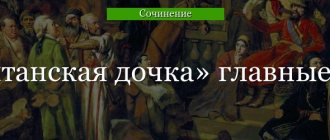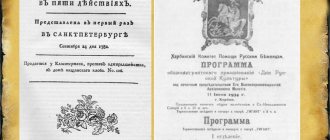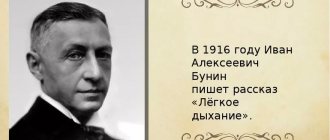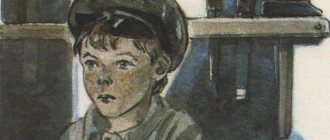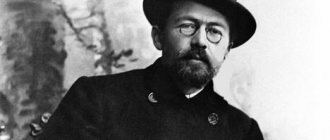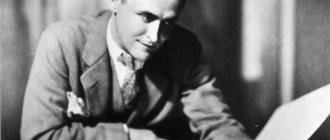Features of romanticism in the story “Makar Chudra”
The main feature of romanticism as a literary movement is dual worlds: the division of the world into the real and the ideal. The story depicts an ideal world of freedom, beauty, songs and music, beautiful freedom-loving people. Already in the exhibition, Makar Chudra contrasts the eternal vegetation of ordinary people, their shameful slavery with freedom and understanding of the world. People, according to the hero, are not born to “pick up the earth.” He thinks about a person: “Does he know his will? Is the expanse of the steppe clear? Does the sound of the sea wave gladden his heart?” This is precisely the meaning and purpose of life: in understanding the world, learning its secrets. What else becomes clear when we analyze the story “Makar Chudra”?
The focus in romanticism is on the exceptional hero, free, beautiful, standing above the surrounding everyday life. Such heroes in the story are Loiko Zobar and Radda. Most of all they value the ideal of freedom. Heroes are guided by feelings, passion, and not reason.
Landscape in romanticism is not just a backdrop for action, it carries a special meaning. The love of romantics for sea and mountain views is well known. It is in the vast expanses of the sea and mountains that the free and passionate soul of an exceptional hero can find a response. The main technique when depicting nature is personification: “the sea sang a gloomy and solemn hymn,” “the darkness of the autumn night shuddered” and timidly moved away. Makar Chudra, a philosopher, a wise old gypsy, is in complete unity with the surrounding world, the quiet splash of waves, the beauty of the sea.
In the finale, the narrator seems to be immersed in an ideal world: the melody of the sea draws him to where the proud Loiko Zobar and the beautiful Radda are circling in an eternal dance.
The meaning of the story
Showing a worldview that is exotic for the majority of the readership, Gorky reminds the public of the natural, primordial beginning of man, when he was not tied to his place, home, things. The author's position is expressed in rejection of a slavish attitude towards life. It is worth remembering that this writer will later say: “Man, that sounds proud.” Gorky is outraged by the cowardice of people, their attention to public opinion, and thoughtless adherence to accepted orders. It is worth noting that he does not follow the path of ridiculing the current situation. A different method is proposed here: it shows people of other faiths with completely different values and preferences.
The idea of “Makar...” is to remember your individuality and not merge with the masses. Perhaps Gorky hopes that his creation will make the same bewitching impression on the reader as on the young listener of Makar Chudra. Thus, people will awaken the desire to discover a new life.
Interesting? Save it on your wall!
Analysis of the story “Makar Chudra” - conflict
In his short story, Gorky touches on several serious topics. These are questions about freedom and slavery, the meaning of human life, the beauty of nature and the world as a whole, about love and self-love.
The conflict is based on the antithesis between freedom and slavery. For Makar Chudra, freedom is the opportunity to enjoy life, the absence of any restrictions. Loiko and Radda value, above all, personal freedom, independence from other people, not only externally, but also internally. They place will above everything, even above love. This is the main conflict. For heroes, to fall in love means to submit to another person, and they cannot do this, it is contrary to their nature. Therefore, a vicious circle situation arises. It is no coincidence that Radda says: “At will, Loiko, I love more than you. And I can’t live without you, just as you can’t live without me.” Even a brief analysis of the story “Makar Chudra” makes it possible to clearly understand this idea.
A beautiful gypsy can only love a strong man, whom she cannot make submissive to herself, but, having fallen in love, she will not submit herself. She gives her lover a task to test him, and knows in advance that Loiko will not fulfill the condition of bowing to her in front of the entire camp. Therefore, when the gypsy plunges a knife into her chest, Radda, smiling, says that she knew what he would do. She smiles because the hero passed the test of strength of character and love of freedom, he turned out to be worthy of Radda’s love. But the paradox is that love and pride turned out to be incompatible, so the heroes die.
This article presented an analysis of the story “Makar Chudra”. We hope you found this article helpful. Our literary blog was created with the aim of highlighting different aspects of works of world literature and their authors.
Conflict
The main conflict of the work is freedom and slavery. The story is permeated by the collision of two fundamentally different worldviews: people of a nomadic lifestyle and a sedentary one. It is this conflict that becomes the impetus for remembering the legend of Loika Zobar. Some value freedom, both internal and external, which is expressed in the refusal to own material wealth and independence from anyone. The inability to obey is explained by pride and self-esteem. Any admiration for such a person is seen as slavery, with which a free soul will never agree.
This attitude to life led to the death of two young people who continue to be admired even after death. Radda admitted that she loves Loika, but still freedom is more than him. The passionately loving gypsy could not come to terms with such a revelation: he could not lose his will for the sake of someone who could not make the same sacrifice.
Essay by Makar Chudra
Makar Chudra is an old, freedom-loving, proud gypsy, a storyteller about real free gypsy life and the main character of the story of the same name by Maxim Gorky. He is the personification of everything the gypsy people love will more than life. Makar has lived a long life at the age of 58 and has a daughter, Nonka. Despite the wandering lifestyle of the gypsies, it looks dignified, and the interlocutor compares it with an ancient, mighty oak tree.
Chudra wanders around the world, enjoying freedom, and does not stay long in one place. He considers his motto to be that you should not sit in one place, you need to wander around the world and look. And only when you’ve seen enough of everything, you can lie down and prepare for death. With his interlocutor, Makar shares his thoughts about people, calling them strange because they live in crowds, despite the fact that there is plenty of space around and people work, giving drops of their strength into the ground, and then die before they can dig their own graves. In his opinion, a person cannot be a teacher for another until he himself has gained the highest worldly wisdom.
Makar himself claimed that he had already been everywhere without staying anywhere for long. Once he was even imprisoned and thought about taking his own life due to lack of freedom.
Chudra also told his interlocutor a tragic story about a daring couple of gypsies, the wayward beauty Radda and the beloved Loiko Zobar, who, loving each other, could not lose their personal freedom and preferred an independent and proud death. With admiration and pride for his entire gypsy people, Makar described the brave gypsy Loiko. Talking about him, Makar characterizes Zobar as a comrade endowed with great wisdom and fearlessness, also a talented musician. He uses no less laudatory epithets in relation to Radda. This gypsy was able to conquer anyone with her beauty, but her pride and love of freedom left no one a chance to win her love.
In the pair of these real gypsies, the image of Makar Chudra himself was reflected, who considered his ideal to be a proud and independent person, not burdened with everyday worries. Only death can deprive a person of freedom, such is Makar’s philosophy.
Lesson topic: Romanticism of M. Gorky in the story “Makar Chudra”
Lesson objectives:
1.Subject:
- form the concept of neo-romanticism and the new romantic hero on the basis of the familiar concepts of “romanticism”, “romantic hero”;
- develop the ability to analyze works of fiction in the unity of form and content;
2. Meta-subject:
●develop students’ ability to conduct a discussion and defend their point of view;
●to foster independent thinking;
●to form an active civic position, a humanistic worldview;
3. Personal:
●development of independence and personal responsibility for one’s actions based on ideas about moral standards, social justice and freedom.
Lesson type
: a lesson in artistic perception.
You go, well, go your own way, without turning to the side. Go straight ahead. Maybe you won’t lose your life in vain. That's it, falcon! M. Gorky
During the classes
Teacher: You are on the threshold of adulthood. And life in society imposes certain responsibilities on an adult. Children are always carriers of certain values. Moving from one community to another, from one team to another, a person brings his own systems of values and requirements into the world of people. Do you know that every action, every desire is reflected in people? Do you check your actions with your consciousness: am I causing harm, trouble, or inconvenience to people? Can I do good unselfishly? And today neo-romanticism is very modern, preaching the return to literature of a real hero who himself makes a choice of life path in favor of a heroic deed. It depends only on the person himself how he will live his life - boring, ordinary, uninteresting or bright, sublime, beautiful. And M. Gorky said this very accurately (epigraph).
I. Organizational moment. Setting goals and objectives for the lesson.
1. What are our activities today?
2. What are your expectations from our conversation? (Using the AMO technique)
II. Intellectual warm-up:
Interpret the terms:
1.Romanticism is a special type of worldview; at the same time – an artistic direction. Romanticism arose as a kind of reaction to the rationalism and unmotivated optimism of classicism.
2. Romantic tradition - historically established customs, orders, and rules of behavior passed on from generation to generation; Name the representatives.
3. Main features of romanticism:
- proclamation of the human personality, complex, deep;
- affirmation of the inner infinity of human individuality;
- a look at life “through the prism of the heart”;
- interest in everything exotic, strong, bright, sublime;
- attraction to fantasy, conventional forms, a mixture of low and high, comic and tragic, ordinary and unusual;
- painful experience of discord with reality;
- refusal of the ordinary;
- the individual’s desire for absolute freedom, for spiritual perfection, an unattainable ideal, combined with an understanding of the imperfection of the world.
The hero is head and shoulders above other people who find themselves next to him; he rejects their company. This is the reason for the loneliness so typical of the romantic, which he most often thinks of as a natural state, because people do not understand it and reject his ideal. Therefore, the romantic hero finds an equal beginning only in communication with the elements, with the world of nature, the ocean, sea, mountains, coastal rocks. That is why the landscape, devoid of halftones, based on bright colors, expressing the most indomitable essence of the elements, receives such great importance in romantic works and its beauty and exclusivity. The landscape is thus animated and, as it were, expresses the originality of the hero’s character.
For the romantic consciousness, the correlation of character with real life circumstances is almost unthinkable - this is how the most important feature of the romantic artistic world is formed: the principle of romantic duality. The romantic, and therefore ideal, world of the hero is opposed to the real world, contradictory and far from the romantic ideal. The contrast between romance and reality, romance and the surrounding world is a fundamental feature of this literary movement.
4.The concept of romanticism;
III
.
Objective: to ensure a favorable climate for work in the classroom and psychologically prepare students for communication and the upcoming lesson.
Teacher: Try to draw a portrait of a romantic hero, just do it without a brush and paints, but with the help of words. Will Mtsyri, Makar Chudra and Loiko Zobar be like him?
Conclusion: The portraits may be different, but the similarities between the characters are truly striking. Each of them values freedom above all else; They treat money the same way as Radda, as the last thread that makes them, at least temporarily, come into contact with human society.
IV.Assimilation of new knowledge.
Task: to use various ways to activate the mental activity of students, to include them in search work.
Work in pairs:
-Identify signs of neo-romanticism.
Teacher:
determine the features of the portrait of Radda and Loiko. What are they?
-What are the life values of the heroes of the legend?
Loiko Zobar: “Was he afraid of anyone!”; “He didn’t have what was cherished - you need his heart, he himself would tear it out of his chest and give it to you, if only you felt good from him”; “With such a person you become a better person” (words of Makar Chudra about Loiko); “...I am a free person and I will live the way I want!”; “She loves her will more than me, and I love her more than my will...”
Radda: “I’ve never loved anyone, Loiko, but I love you. And I also love freedom! That’s it, Loiko, I love you more than you.”
At the end of the story, Makar Chudra skeptically listens to the narrator, an autobiographical hero.
At the end of the work, the narrator sees how the handsome Loiko Zobar and Radda, the daughter of the old soldier Danila, “were spinning in the darkness of the night smoothly and silently, and the handsome Loiko could not catch up with the proud Radda.”
The narrator’s words reveal the author’s position - admiration for the beauty of the heroes and their uncompromisingness, the strength of their feelings, an understanding of the impossibility for the romantic consciousness of the futility of such an outcome: after all, even after death, Loiko in his pursuit will not be equal to the proud Radda.
Conclusion:
Gorky does not change the tradition of romanticism: through external beauty, he highlights the most important character traits of the hero - the desire for freedom. But, unlike other romantic works, in the story “Makar Chudra” we will not find a detailed verbal portrait, the only thing the author pays attention to is Loiko’s mustache, and about Radda he says that her beauty cannot be described if you only play the violin .
Teacher:
-What conflict lies at the heart of the legend?
-How is it resolved?
Makar Chudra has in his character the only principle that he believes to be true: a maximalist desire for freedom. The same single principle, brought to its maximum extent, is embodied by the heroes of the legend told by him. For Loiko Zobar, freedom, openness and kindness are also true values. Radda is the highest, exceptional manifestation of pride that even love cannot break.
Makar Chudra is absolutely sure that pride and love, two beautiful feelings brought to their highest expression by romantics, cannot be reconciled, because compromise is unthinkable for the romantic consciousness. The conflict between the feeling of love and the feeling of pride that the heroes experience can only be resolved by the death of both:
a romantic cannot sacrifice either love that knows no boundaries or absolute pride.
Does the hero-narrator agree with them?
-How is his position expressed?
Teacher:
How does Bitter create a romantic character? The role of landscape?
Makar Chudra is depicted against the background of a romantic landscape: “A damp, cold wind blew from the sea, spreading across the steppe the pensive melody of the splash of an incoming wave and the rustling of coastal bushes. Occasionally his gusts brought with them wrinkled, yellow leaves and threw them into the fire, fanning the flames; the darkness of the autumn night that surrounded us shuddered and, timidly moving away, revealed for a moment the boundless steppe on the left, the endless sea on the right and directly opposite me - the figure of Makar Chudra ... "
The landscape is animated, the sea and the steppe are limitless, emphasizing the boundlessness of the hero’s freedom, his inability and unwillingness to exchange this freedom for anything. The position of the protagonist is already outlined in the exposition; Makar Chudra talks about a person, from his point of view, who is not free: “They are funny, those people of yours. They huddled together and crushed each other. And there’s so much space on earth...”; “Does he know his will? Is the expanse of the steppe clear? Does the sound of the sea wave make his heart happy? He is a slave - as soon as he was born, he is a slave all his life, and that’s it!”
Teacher:
The peculiarity of the composition of this story
, as already mentioned, is that the author puts a romantic legend into the mouth of the main character. It helps us to better understand his inner world and value system. For Makar Chudra, Loiko and Rudd are ideals of love of freedom. He is sure that two beautiful feelings, pride and love, brought to their highest expression, cannot be reconciled. A person worthy of emulation, in his understanding, must preserve his personal freedom at the cost of his own life. Another feature of the composition of this work is the presence of the image of the narrator. It is almost invisible, but we can easily recognize the author himself in it. He doesn't quite agree with his hero. We do not hear any direct objections to Makar Chudra. The independence and pride of these people, of course, delight and attract, but these same traits doom them to loneliness and the impossibility of happiness. They are slaves to their freedom, they are not able to sacrifice even for the people they love. To express the feelings of the characters and his own, the author widely uses the technique of landscape sketches. The seascape is a kind of frame for the entire storyline of the story. The sea is closely connected with the mental state of the heroes: at first it is calm, only the “wet, cold wind” carries “across the steppe the thoughtful melody of the splash of a wave running onto the shore and the rustling of coastal bushes.” But then it began to rain, the wind became stronger, and the sea rumbled dully and angrily and sang a gloomy and solemn hymn to the proud couple of handsome gypsies. In general, a characteristic feature of this story is its musicality. Music accompanies the entire story about the fate of the lovers. “You can’t say anything about her, this Radda, in words. Perhaps its beauty could be played on a violin, and even then to someone who knows this violin like his own soul.”
Group work: I invite you to think...
Goal: to promote the development of emotional and creative freedom in the group based on solving a common problem.
Examination
Reflection:
You define our society. Those historical events that fill our days. You can overcome doubts only by building your path to the truth.
What is it like for you after coming into contact with the fate of M. Gorky’s heroes? Exercise. Problematic question
. Why does the story telling the story of Loiko and Radda bear the name of the narrator - “Makar Chudra”?
Answer
. The consciousness and character of Makar Chudra become the main subject of the image. For the sake of this hero, the story was written, and he needs the artistic means used by the author in order to show the hero in all his complexity and inconsistency, in order to explain his strength and weakness. Makar Chudra is at the center of the story and receives the maximum opportunity for self-realization. The writer gives him the right to talk about himself, freely expressing his views. The legend he told, while possessing undeniable artistic independence, nevertheless serves primarily as a means of revealing the image of the main character, after whom the work is named.
Homework:
*What does Chudra himself call his narrative?
** What new appears in the character of the romantic hero in the work of M. Gorky?
*** Using symbols, depict your path to truth.
5
